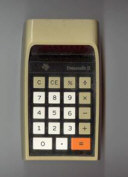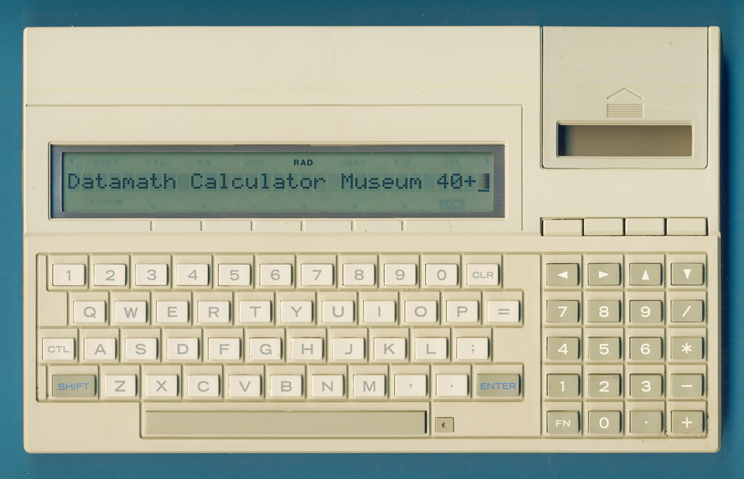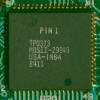
DATAMATH CALCULATOR MUSEUM
 |
DATAMATH CALCULATOR MUSEUM |
Texas Instruments Compact Computer 40 Plus (DVT)
| Date of introduction: | January 1984 Available never |
Display technology: | LCD dot matrix |
| New price: | Display size: | 31 (10 + 3) | |
| Size: | 5.8" x 9.3" x 1.0" 148 x 236 x 25 mm3 |
||
| Weight: | 19.8 ounces, 560 grams | Serial No: | 747 |
| Batteries: | 4*AA Alkaline | Date of manufacture: | wk 15 year 1984 |
| AC-Adapter: | AC9201, AC9201/E | Origin of manufacture: | USA (X) |
| Precision: | 13/14 | Integrated circuits: | CPU:
TMC70C40 75305 ASIC: TP0373 ROM: HN61256P RAM: 3*HM6116LP DISPLAY: HD44780A, HD44100 |
| Memories: | 6kB RAM, 34kB ROM | ||
| Program steps: | Courtesy of: | Joerg Woerner |

![]()
 Texas Instruments introduced in January 6, 1983 with the
Compact Computer 40
or CC-40 a battery-operated but yet powerful computer based on an 8-bit
microcontroller from the TMS7000
family.
Texas Instruments introduced in January 6, 1983 with the
Compact Computer 40
or CC-40 a battery-operated but yet powerful computer based on an 8-bit
microcontroller from the TMS7000
family.
 The
CC-40 was a result of the "Project X"
initiated already in Summer 1977 and leading to the development of the failed
TI Programmable 88 and
Compact Computer 70 aka CC-70, too.
The
CC-40 was a result of the "Project X"
initiated already in Summer 1977 and leading to the development of the failed
TI Programmable 88 and
Compact Computer 70 aka CC-70, too.
 The CC-40
Plus can operate about 200 hours with its disposable
alkaline batteries and
keeps programs and user data even when powered off for several months. It was
priced similar to programmable calculators like the
TI-59 or
TI-88 and continued the idea of Solid
State Software Modules with its integrated Cartridge Port.
The CC-40
Plus can operate about 200 hours with its disposable
alkaline batteries and
keeps programs and user data even when powered off for several months. It was
priced similar to programmable calculators like the
TI-59 or
TI-88 and continued the idea of Solid
State Software Modules with its integrated Cartridge Port.
 The CC-40
introduced with the HEX-BUS a very innovative port to connect peripherals in a
daisy-chain mode very similar to the USB port released more than a decade later.
One of the peripherals planned for the Compact Computer family was the
HX-2000 Wafertape, a continuous loop tape drive developed by Exatron and known as
Stringy Floppy.
The CC-40
introduced with the HEX-BUS a very innovative port to connect peripherals in a
daisy-chain mode very similar to the USB port released more than a decade later.
One of the peripherals planned for the Compact Computer family was the
HX-2000 Wafertape, a continuous loop tape drive developed by Exatron and known as
Stringy Floppy.
The HX-2000 Wafertape had major reliability issue and was never released to the market. Without any other means for mass storage of programs and data, Texas Instruments developed consequently the Compact Computer 40 Plus with an integrated port to connect a cassette audio recorder to save programs or data files on tape.
Texas Instruments dropped out of the home computer market in March 1984 - after selling more than 2.5 million of the famous TI-99/4A - and production of the CC-40 was ceased immediately after. The CC-40 Plus never made it to the market and only a few prototypes from two different Builds or modifications (learn more about the Five Engineering Stages):
|
• CC-40 Plus DVT (Design
Validation Test): Unfinished Housing • CC-40 Plus PVT (Production Validation Test): Final Housing |
It took another two years before Texas Instruments introduced with the TI-74 BASICALC and TI-95 PROCALC the successors of both the TI-88 and CC-40/CC-40 Plus. Five different members of the Compact Computer System are known, only two of them where actually released:
Part |
Name / Description |
MSRP (1983) |
Status |
| CC-40 2K | Prototype of CC-40 with 2k RAM and first design of the Expansion Cartridge | t.b.d. | Prototype |
| CC-40 6K | Standard Version | $249.95 | Series |
| CC-40 18K | Integrated Memory Expansion | t.b.d. | Series |
| CC-40 Plus | Integrated cassette port | t.b.d. | Prototype |
| CC-70 | 8-line Display and Multi-Port Expansion Cartridge | t.b.d. | Mockup |
The Compact Computer 40 Plus uses the proprietary HEX-BUS to connect peripherals, eight different products like printers, plotters and even a serial interface were available or planned:
Part |
Name / Description |
MSRP (1983) |
Status |
| HX-1000 | Printer / Plotter 4 colors | $199.95 | Series |
| HX-1010 | Printer 80 (Thermal ribbon) | $249.95 | Series |
| HX-1100 | Video Interface | $99.95 | Prototype |
| HX-2000 | Wafertape Digital Tape Drive | $139.95 | Prototype |
| HX-3000 | RS-232 Interface | $99.95 | Series |
| HX-3000/P | RS-232 + Parallel Interface | $124.95 | Series |
| HX-3100 | Data Modem | $99.95 | Series |
| HX-5102 | Disk Drive/Controller | t.b.d. | Prototype |
The integrated cartridge port of the Compact Computer 40 Plus supports not only pre-programmed Solid State Software Modules like the TI-59, but allows RAM based Memory Expansions and UV EPROM Program Cartridges. Today we know twelve different cartridges but not all of them were released as of March 1984 when the complete Compact Computer portfolio was discontinued:
Part |
Name / Description |
MSRP (1983) |
ROM-Code |
Status |
| SS-1000 | 16k RAM Memory Expansion | $149.95 | n.a. | Series |
| SS-1001 | Pascal module | $59.95 | n.a. | Series |
| SS-2000 | 8k RAM Memory Expansion with Li-Backup Battery | $99.95 | n.a. | Series |
| SS-3004 | Memo Processor for Data Communications | $69.95 | 1500387 4000 |
Series |
| SS-3006 | Finance module | $59.95 | 1500387 1100 |
Series |
| SS-3007 | Advanced Electrical Engineering module | $59.95 | 1500387 1202 |
Series |
| SS-3008 | Statistics module | $59.95 | 1500387 xxxx |
Series |
| SS-3009 | Mathematics module | $59.95 | 1500387 1003 |
Series |
| SS-3024 | Games I module | $39.95 | 1500387 xxxx |
Series |
| SS-4002 | Editor/Assembler (Requires Wafertape or Disk Drive/Controller) | $124.95 | 1500387 9100 |
Prototype |
| 8K-EPROM | 8k UV EPROM Program Cartridge | t.b.d. | n.a. | Prototype |
| 16K-EPROM | 16k UV EPROM Program Cartridge | t.b.d. | n.a. | Prototype |

 Dismantling
the featured Compact Computer 40 Plus DVT (Design Validation Test) manufactured in
April 1984 by Texas Instruments in their Abilene, TX facility, reveals a neat
design with just two printed circuit boards (PCBs) that changed completely from
the original CC-40. The orientation of the Main-PCB was reversed with the new
design and the components face now downwards instead of upwards. This change
allowed not only for soldering the connector for the tape recorder directly onto
the Main-PCB, but for a much easier connection to the
second PCB with the LC-Display and keyboard contacts. The only differences
observed to the CC-40 Plus PVT manufactured in May 1984 seems to be the finish
of the housing, both color and printing changed between the two Builds.
Dismantling
the featured Compact Computer 40 Plus DVT (Design Validation Test) manufactured in
April 1984 by Texas Instruments in their Abilene, TX facility, reveals a neat
design with just two printed circuit boards (PCBs) that changed completely from
the original CC-40. The orientation of the Main-PCB was reversed with the new
design and the components face now downwards instead of upwards. This change
allowed not only for soldering the connector for the tape recorder directly onto
the Main-PCB, but for a much easier connection to the
second PCB with the LC-Display and keyboard contacts. The only differences
observed to the CC-40 Plus PVT manufactured in May 1984 seems to be the finish
of the housing, both color and printing changed between the two Builds.
The Main-PCB of the CC-40 Plus illustrates still a
design with four main building blocks:
![]() CPU
(Central processing Unit): The Texas Instruments TMC70C40 microcontroller is a
member of the
TMS7000 family
manufactured in CMOS technology. The original design of the TMS7000 series was
introduced in 1981 as an 8-bit extension of the
TMS1000 Family to compete with
already well established Intel i8051, Motorola M6801, and Zilog Z8 products. The
first chips sported 128 bytes of on-chip RAM (Random Access Memory) and either
2k Bytes or 4k Bytes of ROM (Read Only Memory). The featured CC-40 Plus PVT uses with the TMC70C40 with ROM-Code 75305 a device
with 4k Bytes ROM capacity while the original design of the CC-40 is based on the
TMC70C20 equipped with 2k Bytes of ROM. The additional ROM of the
microcontroller is mainly used for the low-level functions of the cassette
recorder audio interface.
CPU
(Central processing Unit): The Texas Instruments TMC70C40 microcontroller is a
member of the
TMS7000 family
manufactured in CMOS technology. The original design of the TMS7000 series was
introduced in 1981 as an 8-bit extension of the
TMS1000 Family to compete with
already well established Intel i8051, Motorola M6801, and Zilog Z8 products. The
first chips sported 128 bytes of on-chip RAM (Random Access Memory) and either
2k Bytes or 4k Bytes of ROM (Read Only Memory). The featured CC-40 Plus PVT uses with the TMC70C40 with ROM-Code 75305 a device
with 4k Bytes ROM capacity while the original design of the CC-40 is based on the
TMC70C20 equipped with 2k Bytes of ROM. The additional ROM of the
microcontroller is mainly used for the low-level functions of the cassette
recorder audio interface.
![]() ROM (Read-Only Memory): The ROM contains the operating
system of the calculator or computer. The first products on the market used
mask-programmable ROM, the program was stored already during the production
of the Integrated Circuit. Later calculators changed to Flash ROM, a
technology allowing the programming of the software during the final production
stage of the calculator. With the TI-83 Plus and all later graphing calculators
from Texas Instruments even the user was able to reprogram the operating system.
ROM (Read-Only Memory): The ROM contains the operating
system of the calculator or computer. The first products on the market used
mask-programmable ROM, the program was stored already during the production
of the Integrated Circuit. Later calculators changed to Flash ROM, a
technology allowing the programming of the software during the final production
stage of the calculator. With the TI-83 Plus and all later graphing calculators
from Texas Instruments even the user was able to reprogram the operating system.
The
HN61256P ROM of this CC-40 Plus was manufactured by Hitachi and offers a capacity of 32k
Bytes for the BASIC interpreter.
![]() RAM
(Random Access Memory): The RAM is used as data memory and is used to store both variables, user programs and intermediate results. This
CC-40 Plus makes use of three HM6116 manufactured by Hitachi, Japan with 2k Bytes
capacity, each. The total capacity of the memory is 6k Bytes using three HM6116LP chips,
other versions of the CC-40 Plus were planned featuring 18k
Bytes of memory using one HM6116LP and two HM6264LP (8k Bytes) chips.
RAM
(Random Access Memory): The RAM is used as data memory and is used to store both variables, user programs and intermediate results. This
CC-40 Plus makes use of three HM6116 manufactured by Hitachi, Japan with 2k Bytes
capacity, each. The total capacity of the memory is 6k Bytes using three HM6116LP chips,
other versions of the CC-40 Plus were planned featuring 18k
Bytes of memory using one HM6116LP and two HM6264LP (8k Bytes) chips.
 ASIC:
The CC-40 Plus uses a TP0373 application-specific integrated
circuit (ASIC) with a Date code
8411 designed by Texas Instruments and manufactured in March 1984 in the United
States by an unknown company. It contains the "glue logic" to connect the
memories, keyboard and LC-Display to the TMC70C40 microcontroller and integrates
the Hex-Bus Peripheral port. With the Hitachi HN61256P used with the CC-40 Plus
and its Solid State Software Cartridges featuring a rather long access time of
up to 3.5 us and the TMC70C40 CPU lacking a "wait-state" mechanism, incorporates
the ASIC additional circuitry to slow down the CPU clock cycle while accessing
the ROM chips. The TMC70C46 chip used with the TI-74 BASICALC and TI-95 PROCALC
integrated all these features and dropped the additional ASIC found with the
CC-40/CC-40 Plus design completely.
ASIC:
The CC-40 Plus uses a TP0373 application-specific integrated
circuit (ASIC) with a Date code
8411 designed by Texas Instruments and manufactured in March 1984 in the United
States by an unknown company. It contains the "glue logic" to connect the
memories, keyboard and LC-Display to the TMC70C40 microcontroller and integrates
the Hex-Bus Peripheral port. With the Hitachi HN61256P used with the CC-40 Plus
and its Solid State Software Cartridges featuring a rather long access time of
up to 3.5 us and the TMC70C40 CPU lacking a "wait-state" mechanism, incorporates
the ASIC additional circuitry to slow down the CPU clock cycle while accessing
the ROM chips. The TMC70C46 chip used with the TI-74 BASICALC and TI-95 PROCALC
integrated all these features and dropped the additional ASIC found with the
CC-40/CC-40 Plus design completely.

 The front view of the
second PCB
shows the dot matrix LC-Display with 31 characters width and the contacts of the
61 keys of the keyboard. The back of the second PCB reveals the control and
driver electronics for the LC-Display:
The front view of the
second PCB
shows the dot matrix LC-Display with 31 characters width and the contacts of the
61 keys of the keyboard. The back of the second PCB reveals the control and
driver electronics for the LC-Display:

 DISPLAY:
The CC-40 Plus uses like its predecessor CC-40 the Hitachi HD44780 LCD Controller and one additional Hitachi
HD44100 LC Driver. The HD44780 contains the character generator for 208
characters in a 5x8 dot matrix, 32 characters in a 5x10 font, RAM for a maximum
of 80 characters and the driver electronics for 16 characters. The HD44100 adds
an additional 40 segment drivers for the remaining characters.
DISPLAY:
The CC-40 Plus uses like its predecessor CC-40 the Hitachi HD44780 LCD Controller and one additional Hitachi
HD44100 LC Driver. The HD44780 contains the character generator for 208
characters in a 5x8 dot matrix, 32 characters in a 5x10 font, RAM for a maximum
of 80 characters and the driver electronics for 16 characters. The HD44100 adds
an additional 40 segment drivers for the remaining characters.
If you have additions to the above article please email: joerg@datamath.org.
© Joerg Woerner, December 29, 2020. No reprints without written permission.